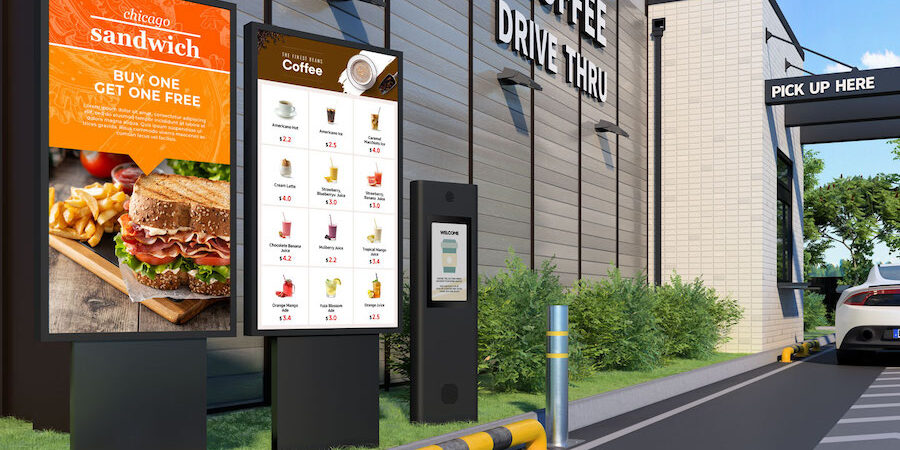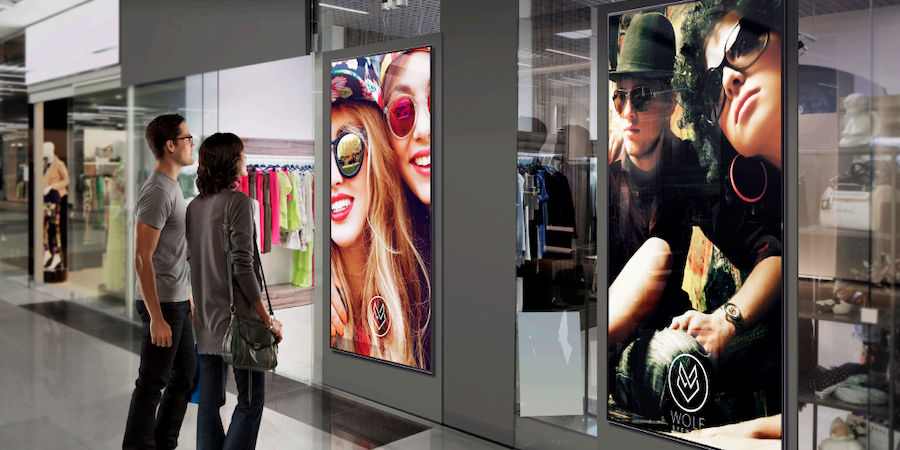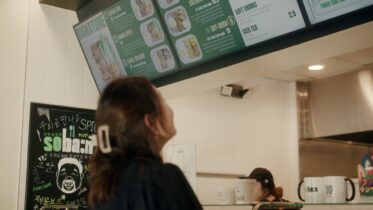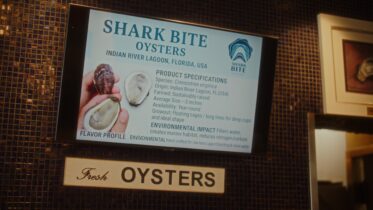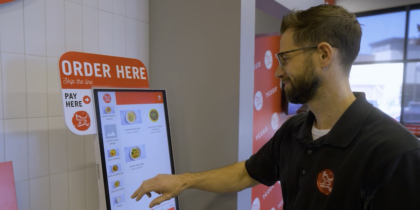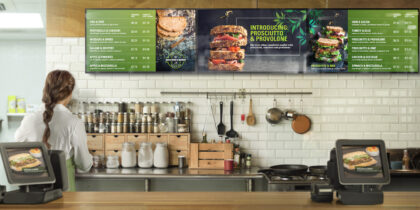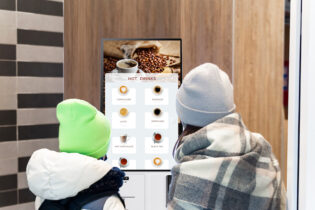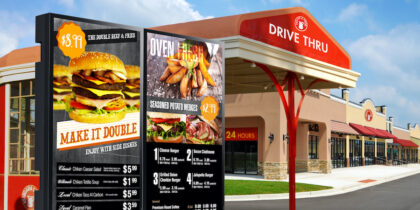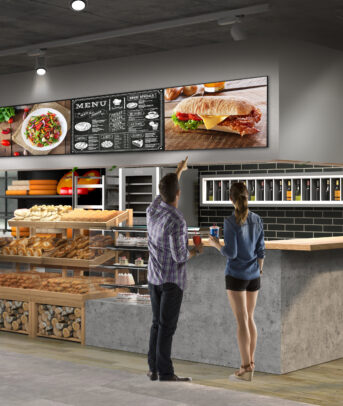Facing increased competition from convenience stores, which have upped their food-service game in recent years, quick service restaurants (QSRs) are turning to technology to stay ahead of the competition. With 8 in 10 operators saying the use of restaurant technology provides a competitive advantage, many are ramping up their investments and looking to improve convenience with everything from online and app ordering to self-service kiosks, digital displays, and newly installed EV chargers. Consider this must-have technology to improve the customer experience and boost sales at your QSR.
Draw customers in with digital signage
QSRs can improve the customer experience, both outside and inside their locations, with digital signage. Outdoor signage not only highlights the QSR’s brand, but it drives traffic to their sites. Well-positioned and targeted signs, which promote new menu items and limited-time offers, will appeal to hungry consumers and prompt an impulse stop. This is key, as up to 40% of customers will make an impulse stop at a fast food restaurant or QSR.
According to the Sign Research Foundation, the addition of one sign at every fast-food outlet in Los Angeles can raise business revenues by $132 million. Signage is a way to mark and market businesses. For example, pole-mounted LED signage, such as Samsung’s XPR-B series, is ideal for showcasing menu specials and seasonal promotions in high detail.
Inside, the QSR entrance and window zone can also be used for high-brightness displays to greet customers as they enter the site. Operated remotely via a content management software (CMS) like Samsung VXT, window displays can be updated to promote new products and time-of-day offers to increase basket spend. Restaurant owners and employees can use preconfigured templates in VXT Canvas to quickly create menus and promotions. They can change out menu items and update prices instantly to ensure customers receive the latest information.
Using VXT, content can be created and managed seamlessly across a variety of locations and devices from anywhere around the globe. Changes can also be applied to a specific store or implemented across an entire region or chain. The highly intuitive CMS enables anyone to easily develop and deploy content with no previous training.
With dual-sided displays, such as the Samsung OMN series and OMN-D series, QSRs can schedule unique content for customers both inside and outside to drive maximum value. In addition, Samsung digital signage incorporates FastSensor AI integrations, which can generate heat maps of foot traffic interactions in QSRs. These deliver real-time insights and customer analytics, which QRS can then use to impact purchase behavior.
Coupled with VXT, these capabilities enable an easy way to streamline content management and simplify the use of the displays across the board.
Highlight special offers with vibrant menu boards
With vibrant digital signage and menu boards, QSRs can highlight menu items and the latest promotions and offers. They can also showcase different menus according to time of day, and make menu updates to promote new specials or remove an item if a product becomes unavailable. It puts QSRs in firm control of their inventory and delights customers, as it helps ensure their selections will be available.
Compared to static displays, digital menu displays, such as Samsung’s QB series, deliver significant flexibility for QSRs, with the ability to showcase limited-time offers and update them easily. They can also present discount/flexible pricing, loyalty programs, meal bundles and other value deals to help draw traffic and increase sales. Not to mention, QSRs can promote a retailer’s fresh food credentials to customers, leaving them impressed and coming back for more.
The future of retail is digital
Get your free guide to growing your retail business by adopting future-proof ecommerce technology. Download Now
Enhance customer convenience with mobile ordering and self-service kiosks
Mobile ordering and self-service kiosks improve guest satisfaction and provide a seamless experience by allowing customers to take control of their orders.
In fact, takeout and delivery are considered essential by 55% of consumers, according to the National Restaurant Association. And consumers are not only comfortable with technology to order, pay, and earn rewards at restaurants — but they expect it.
Self-service kiosks are beginning to take center stage at QSRs due to their pivotal role in upselling, as well as helping to alleviate labor challenges. Self-service kiosks tend to speed up transaction times because they are intuitive and customers find the tech easy and convenient to use. They assist with upselling and can suggest add-ons or push promotions and limited-time offers. They have also been shown to increase spending by 20-30% on average and make customers twice as likely to order a dessert.
The technology reduces miscommunication in face-to-face transactions as well, which helps ensure order accuracy and drive customer satisfaction — a key factor in winning repeat visits to a QSR. They can also help with line busting, given they are always on, helping to increase customer satisfaction.
Samsung Kiosk is a sleek, plug-and-play, all-in-one solution that can be mounted on a counter, stand or wall. Easy to install and activate, the kiosk offers transactional security, remote access and mobile device management (MDM) tools that allow IT and operations managers to monitor kiosks across an entire QSR network.
The EV opportunity
Rising customer expectations are prompting QSRs to rely on technologies to create meaningful experiences for their customer base. To keep up with customers’ unique needs, QSRs must seek new opportunities to improve customer convenience at their locations, such as with electric vehicle (EV) charging stations. According to federal data, there are more than 3 million EVs on the road. Not only do EV charging stations support sustainability initiatives, but they can help boost sales when paired with digital signage.
QSRs can use displays at the charging station for advertisements, offers and promotions, driving more traffic inside. Samsung’s partnership with Sprinklr also allows QSRs to deliver real-time customer-generated social media content that features the brand in a positive light or helps customers discover new products while they wait for their cars to charge. QSRs could also incorporate charging in their loyalty programs, offering priority or higher charging speeds to loyalty scheme members, for example. And, as an incentive for guests, QSRs could offer dedicated promotions or discounts that are only available while utilizing the chargers.
A more personalized customer journey
Technology throughout the QSR environment enables operators to personalize content at every step of the customer journey and helps to provide an immersive, connected, and elevated consumer experience. With solutions that draw customers in, allow them to take control, and personalize their experience, Samsung provides a one-stop shop for QSRs looking to go the extra mile.
Explore Samsung’s innovative retail solutions, designed to mobilize your operations and enrich the customer experience. And learn more about how Samsung VXT CMS can streamline and enhance the customer journey. Sign up for a VXT free trial here.
